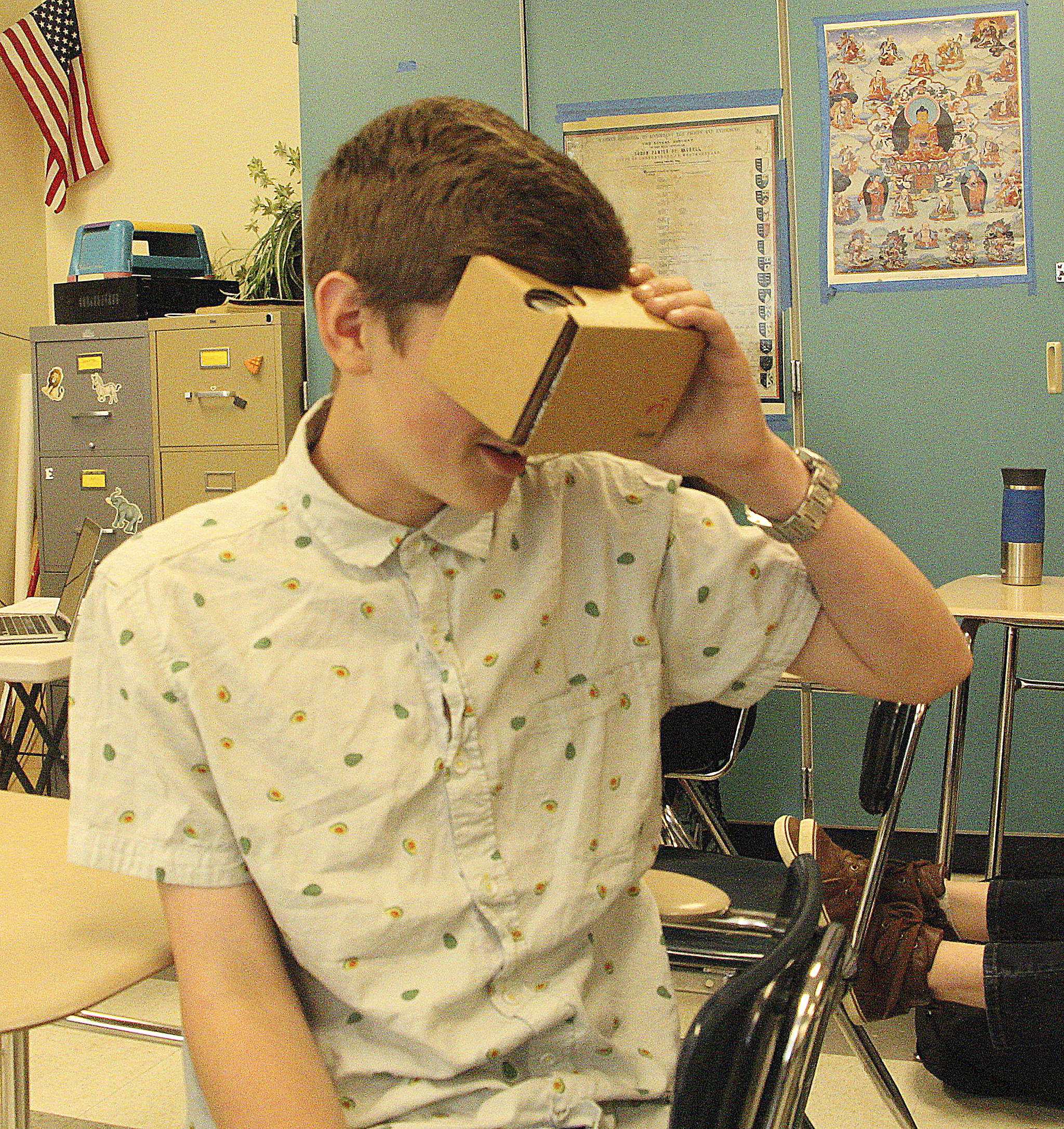by Jessica Stahl
Sounder contributor
What would it take to change your perceptions?
According to Orcas Island High School geography teacher Val Hellar, stereotypes make things and people easy for us to understand. At the same time, they facilitate misunderstandings and limitations.
With the help of a $550 grant from the Orcas Island Education Foundation, Hellar is utilizing virtual reality – computer-generated simulation of a three-dimensional image – with her students to break down these limiting barriers.
“The grant from the foundation allowed us to buy Google Glasses for the class,” said Hellar.
The glasses, which are the Google Cardboard version, are a low-cost VR platform developed by Google for use with a head mount for a smartphone. By pairing the OIEF grant with a classroom deal from Amazon, Hellar is now able to give each of her Advanced Placement Geography students the chance to experience virtual reality. Seated at their desks with glasses on, her ninth grade students have “traveled” to the Great Barrier Reef; Saudi Arabia; Aztec and Mayan ruins; Venice; Mount Everest; and various places in Japan such as Yokohama’s Chinatown, Heian Garden and Miyajima Island.
“It’s amazing. They’ve been swimming with dolphins, visited temples, observed the customs of Ramadan,” said Hellar.
For many, it is their first experience with VR, and the response to the experience is enthusiastic from both students and teacher. The glasses not only allow students to access a three-dimensional experience of other people and places but have the added benefit of a function that helps explain what is being seen.
“Information boxes pop up that explain what you’re looking at,” said ninth grader Kathryn Aspinall. “[In one viewing] I thought people were just tourists. … Then I learned they were actually involved in a religious custom.”
Hellar is a member of the AP Human Geography Teachers Consortium, and it is there she was first inspired by a fellow member to begin a new classroom quest. Hellar wanted to explore how personal perceptions of other people and places can shape our reality, and so began a “perception test” in her class.
Starting in February 2019, she developed a partnership with a teacher in Texas. The two teachers asked their respective students to describe their perceptions and understandings of the student populations in the opposite states. The results are at once a humorous and glaring example of how stereotypes can marginalize a population. The Orcas students described their counterparts as “Trump-loving, cigarette-smoking cowboys who take big-haired prom queens to a football game.” The Texas students, in turn, described Washingtonians as “Dope-smoking, flannel-wearing coffee addicts playing video games in the rain.”
Hellar was intrigued, and curious about how students could learn to look beyond these stereotypes and into the history, culture, and geography of a place.
“I’ve had a prejudice against technology in the classroom but the kids have taught me the value of it, and now it is something we can discuss,” Hellar said. “If they’re going to have these phones that I cannot pry from their sticky fingers, then we need to make it a force for good. It’s a new frontier for me.”
Hellar isn’t working with a curriculum. Instead, she is discovering the glasses’ potential and application as she goes. The Texas-Washington stereotypes gave her the idea that the glasses could help her students understand cultural differences not only abroad but closer to home, too. To this end, she will be working with the Texan teacher to develop ways their students can use VR to better understand the human geography of the others’ states. Hellar also has ideas for how VR can help her students with biology, marine biology, literature, art and more.
“I’m exploring the uses myself, getting beyond gimmicky and learning how to really integrate the VR into what we are teaching,” said Hellar.
For their final class project, students from both states will be sharing their realities with each other. To accomplish this, Hellar’s students are mapping out by video the human geography of Orcas Island, answering questions about islanders’ values, culture, political leanings, population demographics, as well as our social and cultural architecture. The Texas students are making a similar video of their own home environment.
“How we lay out our cities, how land is used, where our industry is located, what our industry is. … These are all questions for human geography,” said Hellar. She isn’t sure yet if a three-dimensional component can be added to the class’s video, but she is optimistic that VR will continue helping her students achieve a broader human perspective.
Beginning next fall, it is likely the glasses will find their way into other classrooms and subjects as well. For all of these opportunities, Hellar expressed gratitude to OIEF and the Orcas community for their support. She’s also happy to report that next year the Orcas and Texan students will be supporting each other by studying for their final AP exam together. Hellar and her Texan counterpart will develop techniques for this out-of-state study grouping over the summer.
However they choose to work together, it is clear they won’t be limited by the walls of their classrooms.
“I have a trip planned to Milky’s Dairy Farm in Scotland next week!” said Hellar.



